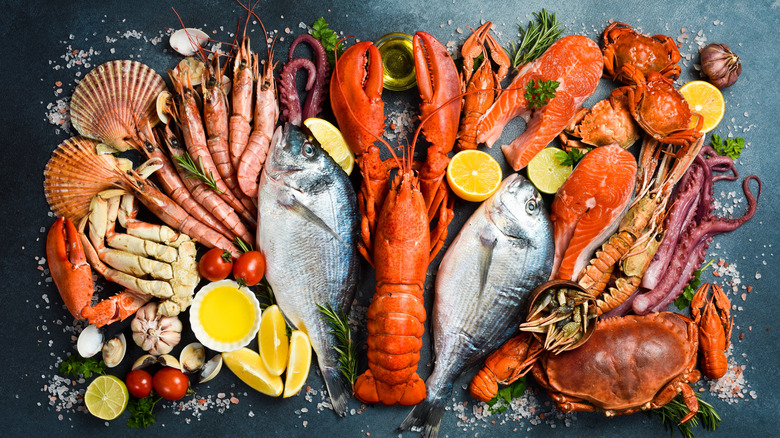This Once-Popular Seafood Dish Dates Back To The 1800s
Throughout culinary history, food trends have continually come and gone. Some make a comeback — like these 1950s food revivals — whereas others, once considered premium, fade into obscurity. One prime example of a dish that once graced fine dining menus was lobster Newberg, allegedly created in 1870s New York, featuring succulent lobster pieces in a decadent sauce consisting of butter, cream, cognac, sherry, and eggs, served over toast or in a puff pastry shell. Today, when it comes to luxury lobster dishes, you're more likely to encounter its close relative, lobster Thermidor — a similarly rich dish with its own unique and surprising history.
The widespread popularity of lobster Newberg in the Gilded Age is a testament to lobster's unique trajectory in the American food scene. In colonial America, lobster was cheap and plentiful, often considered a poor man's meal. But the expansion of canning and railway travel in the 19th century gave lobster a new reputation by transforming it into an exotic luxury for those far from the coasts. This rebrand gave rise to a variety of new and beloved lobster dishes, from the luxurious lobster Newberg and lobster Thermidor emerging in the late 19th century, to the more casual yet enduring favourites like lobster rolls, which emerged in the early 20th century, solidifying lobster's reputation as an all-American classic enjoyed by people of all creeds.
While not as popular as it once was, lobster Newberg hasn't been forgotten. March 25 is celebrated as national lobster Newberg day, and restaurants still feature the vintage dish on their menus. It also boasts some high-profile fans. In an interview with Business Insider, Martha Stewart recalled that Snoop Dog once cooked her the iconic dish.
The alleged history of lobster Newberg
Before diving into the history of lobster Newberg, one thing should be made clear: This is all alleged. No one knows the definitive origins of the dish, but over time modern legend and speculation has become canon in foodie lore. The most popular theory credits its creation to Delmonico's in New York City, a restaurant opened in 1837 that's considered a pioneer of American fine dining, and where you can still enjoy the dish today.
According to legend, a sea captain and regular patron of Delmonico's named Ben Wenberg introduced the recipie to Charles Delmonico, one of the resturant's co-owners. Delmonico was so impressed that he added it to the menu, named "Lobster a la Wenberg" in honor of the captain. The dish became an instant hit, but you might be wondering why the dish no longer known as Lobster a la Wenberg? Well, according to popular legend, a feud of an unknown nature broke about between Delmonico and Wenberg, which saw the dish struck off the menu. Due to popular demand, the dish soon returned, but this time under a new name: Lobster Newberg. The culinary world is no stranger to rivalries – just look at the ongoing debate of who invented pavlova. So it's likely that the name change was a not-so-subtle jab meant to erase all trace of Wenberg's association from the dish. Whether or not this take is entirely true, one thing remains certain — Delmonico's plays a huge part in the history of this dish, to the point that lobster Newberg is sometimes referred to as lobster Delmonico.


